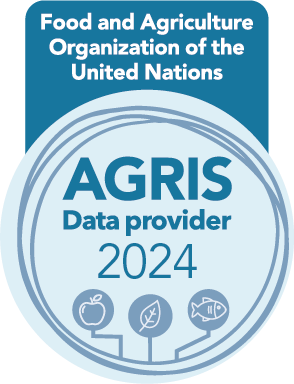Brand competitiveness and consumer preference towards milk and milk-based products Multi-Dimensional Scaling (MDS)
DOI:
https://doi.org/10.14719/pst.5971Keywords:
brand competitiveness, factors, milk, Multi-Dimensional Scaling (MDS)Abstract
This study investigates brand competitiveness and consumer preferences for milk and milk-based products like curd, ghee, butter, sweets, paneer, etc. utilizing Factor Analysis and Multi-dimensional Scaling (MDS) to provide insights into key dimensions influencing brand perception. Factor Analysis identified five critical dimensions that together explain 70.67% of the total variance in brand competitiveness. These dimensions include Best Brand and Customer Satisfaction (18.25%), Quality, Brand Trust and Awareness (14.47%), Price-Value Perception, Availability and Packaging (14.14%), New Products and Health/Nutrition (12.56%) and Loyal Customers and Recommendations (11.23%). The findings emphasize that Brand Reputation, Customer Satisfaction, Quality and Brand Trust are crucial in shaping brand competitiveness, underscoring the importance of meeting consumer expectations. In parallel, MDS analysis mapped consumer perceptions of eight milk brands, highlighting those brands like Tirumala, Sreeja and Sri Venkateswara are positively viewed in terms of value and taste. Conversely, brands such as Vijaya, Arokya, Heritage and Dodla received lower ratings; this suggests a gap between their price and quality or taste of their offerings. These insights are valuable for brands aiming to enhance their market position and align more closely with consumer preferences.
Downloads
References
Ding H, Fu Y, Zheng L, Yan Z. Determinants of the competitive advantage of dairy supply chains: Evidence from the Chinese dairy industry. International Journal of Production Economics. 2019;209:360-73.
Adjei Agyekum G. Consumer considerations of local value-added dairy products in North Carolina's Triangle. 2019.
Kanekanian A. The health benefits of bioactive compounds from milk and dairy products. Milk and dairy products as functional foods. 2014:1-22. https://doi.org/10.1002/9781118635056.ch1
Chaudhary V, Kajla P, Kumari P, Bangar SP, Rusu A, Trif M et al. Milk protein-based active edible packaging for food applications: An eco-friendly approach. Frontiers in Nutrition. 2022;9:942524. https://doi.org/10.3389/fnut.2022.942524
Inoni OR, Ogundare JT. Influencing factors of consumers’brand preference of powdered milk. Innovative economics and management. 2024;11(1):49-67. https://doi.org/10.46361/2449-2604.11.1.2024.49-67
Venkatesa Palanichamy N, Kalpana M, Giruba M, Aruna Prabha S. Assessment of awareness, knowledge, and perception on the purchase intention towards packaged milk. Asian J Adv Agric Res. 2024;24(6):1-12. https://doi.org/10.9734/ajaar/2024/v24i6507
Joubert JP, Poalses J. What's in a name? The effect of a brand name on consumers' evaluation of fresh milk. International Journal of Consumer Studies. 2012;36(4):425-31. https://doi.org/10.1111/j.1470-6431.2011.01065.x
Mwangi AW, Wanjau K. Influence of perceived service quality on consumer satisfaction amongst dairy milk processors in Kenya. International Journal of Research in Business and Social Science (2147-4478). 2018;7(4):44-57. https://doi.org/10.20525/ijrbs.v7i4.893
Ramírez-Rivera E, Rodríguez-Miranda J, Huerta-Mora I, Cárdenas-Cágal A, Juárez-Barrientos JM. Tropical milk production systems and milk quality: a review. Tropical animal health and production. 2019;51(6):1295-305. https://doi.org/10.1007/s11250-019-01922-1
Pooja N. Consumer's trust in a brand, perceived brand value and their relationship with brand loyalty: a case study of saras milk brand, Bikaner, India. 2005.
Nguyen Viet B, Nguyen Anh T. The role of selected marketing mix elements in consumer based brand equity creation: milk industry in Vietnam. Journal of Food Products Marketing. 2021;27(2):72-88. https://doi.org/10.1080/10454446.2021.1892007
da Silva ML, de los Santos Cobas NL, da Matta IB, Juliani LI. Production strategies of a dairy industry in Uruguay. Revista Produção e Desenvolvimento. 2020;6. https://doi.org/10.32358/rpd.2020.v6.439
Hassan M, Zakai SN, Hussain S, Umer M, Iqbal MN. Customer-based brand equity within packaged milk industry: the case of consumer behavior. Turkish Online Journal of Qualitative Inquiry. 2021;12(9).
Oraman Y, Yorgancilar C. The evaluation of marketing strategies of private label milk products from the consumers’perspective: the case of Kocaeli Province. Journal of Management Marketing and Logistics. 2015;2(3). https://doi.org/10.17261/Pressacademia.2015312953

Downloads
Published
Versions
- 25-01-2025 (2)
- 22-01-2025 (1)
How to Cite
Issue
Section
License
Copyright (c) 2025 Gajula Gourav, Balaji Parasuraman, Rohini , Senthilkumar, Vijayabhama Manikkaam, Mugilan Kannan

This work is licensed under a Creative Commons Attribution 4.0 International License.
Copyright and Licence details of published articles
Authors who publish with this journal agree to the following terms:
- Authors retain copyright and grant the journal right of first publication with the work simultaneously licensed under a Creative Commons Attribution License that allows others to share the work with an acknowledgement of the work's authorship and initial publication in this journal.
- Authors are able to enter into separate, additional contractual arrangements for the non-exclusive distribution of the journal's published version of the work (e.g., post it to an institutional repository or publish it in a book), with an acknowledgement of its initial publication in this journal.
Open Access Policy
Plant Science Today is an open access journal. There is no registration required to read any article. All published articles are distributed under the terms of the Creative Commons Attribution License (CC Attribution 4.0), which permits unrestricted use, distribution, and reproduction in any medium, provided the original author and source are credited (https://creativecommons.org/licenses/by/4.0/). Authors are permitted and encouraged to post their work online (e.g., in institutional repositories or on their website) prior to and during the submission process, as it can lead to productive exchanges, as well as earlier and greater citation of published work (See The Effect of Open Access).









